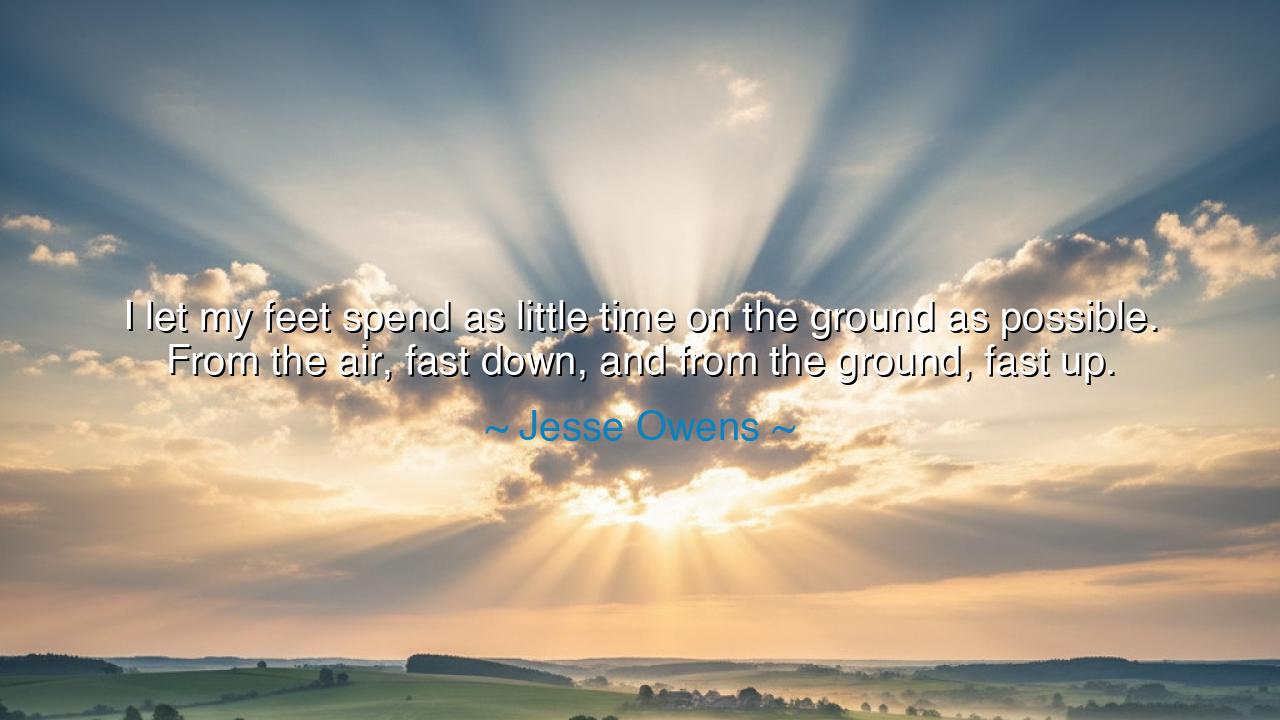
I let my feet spend as little time on the ground as possible.
I let my feet spend as little time on the ground as possible. From the air, fast down, and from the ground, fast up.






The words of Jesse Owens, “I let my feet spend as little time on the ground as possible. From the air, fast down, and from the ground, fast up,” are more than a description of running—they are a philosophy of life itself. Owens, the son of sharecroppers and grandson of enslaved people, turned speed into poetry, rising from humble beginnings to defy not only the limits of his body, but the weight of history. In these words, he reveals the secret of his craft: to live light, to move swiftly, to waste no motion, no moment, no opportunity.
At its core, the quote is about the marriage of discipline and freedom. Owens understood that to be a great runner, one must master the art of touching the earth lightly, as though refusing to be bound by it. His feet were instruments of flight, carrying him over distances in graceful bursts, each step both a release from the ground and a return to it. But within this rhythm of running lies a larger lesson: in life, too, one must not remain shackled to the ground of hardship, but must rise quickly, move forward, and seize the air of possibility.
The origin of this insight comes from Owens’s legendary performance at the 1936 Berlin Olympics, where he won four gold medals in the face of Adolf Hitler’s poisonous ideology of racial superiority. Every time Owens leapt from the ground, every time he sprinted forward with unmatched swiftness, he shattered not only records, but illusions of human inequality. His philosophy of “fast up, fast down” was not just a method of speed—it was a declaration of resilience, that no weight of oppression, no burden of prejudice, could hold him to the ground for long.
History is filled with examples of those who understood this principle. Consider the flight of Wilbur and Orville Wright, who in 1903 refused to let human imagination remain bound to the earth. Their fragile plane lifted into the air, showing that mankind, too, could take flight. Like Owens’s swift feet, their invention was a reminder that greatness belongs to those who refuse to linger in the dust of limitation, who rise again and again until they master the air. Both stories reveal the same truth: that progress belongs to those who learn to rise swiftly after each return to the ground.
The deeper wisdom of Owens’s words is this: life is a series of steps, some in the air and some on the ground. The ground represents the hardships, the falls, the burdens we cannot avoid. The air represents freedom, vision, and possibility. The secret is not to avoid the ground, for no one can, but to learn to rise from it swiftly, not letting it hold us longer than necessary. To stumble is human, but to linger in despair is defeat. To fall and rise quickly—that is victory.
To the seekers of wisdom, let this be a teaching: cultivate the art of resilience. When life casts you down, do not tarry in the dust. Rise as swiftly as your strength allows, and set your eyes once more upon the horizon. Waste no time in bitterness, waste no steps in regret. Like Owens, touch the ground lightly, only enough to gather the power to rise again. In this rhythm of falling and rising, you will find both endurance and triumph.
The practical action is clear: in your daily struggles, when faced with failure, practice rising quickly. Do not let setbacks chain you. Train your body and mind to act like Owens’s feet: swift in recovery, swift in moving forward. Whether in work, in relationships, or in personal growth, waste as little time as possible on the ground of defeat, and devote yourself to the air of hope, the flight of progress, the forward motion of purpose.
Thus, let the words of Jesse Owens endure as both athletic wisdom and life philosophy: do not let the ground hold you. Rise swiftly, move with grace, and embrace the air of possibility. For those who learn this rhythm—fast down, fast up—will find themselves not only runners on the track, but victors in the race of life itself.






AAdministratorAdministrator
Welcome, honored guests. Please leave a comment, we will respond soon